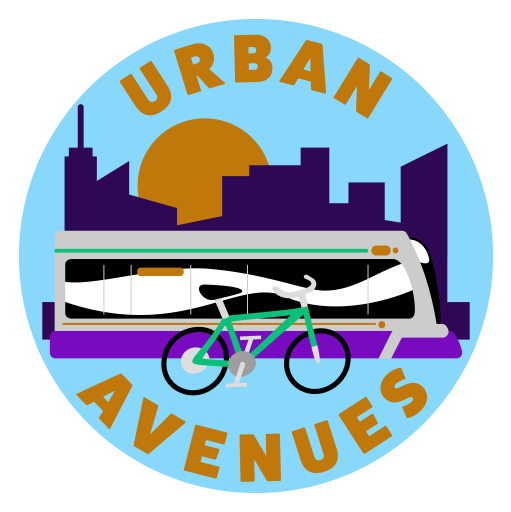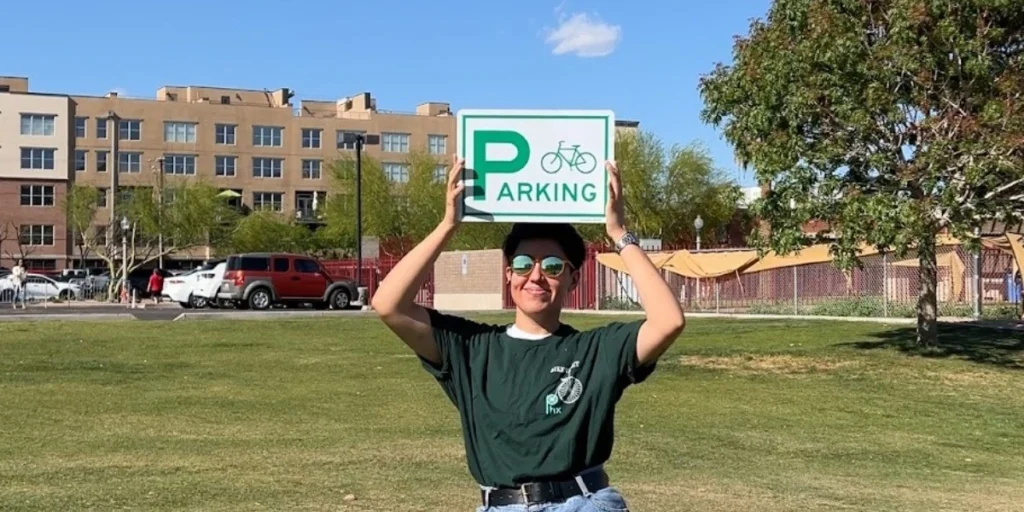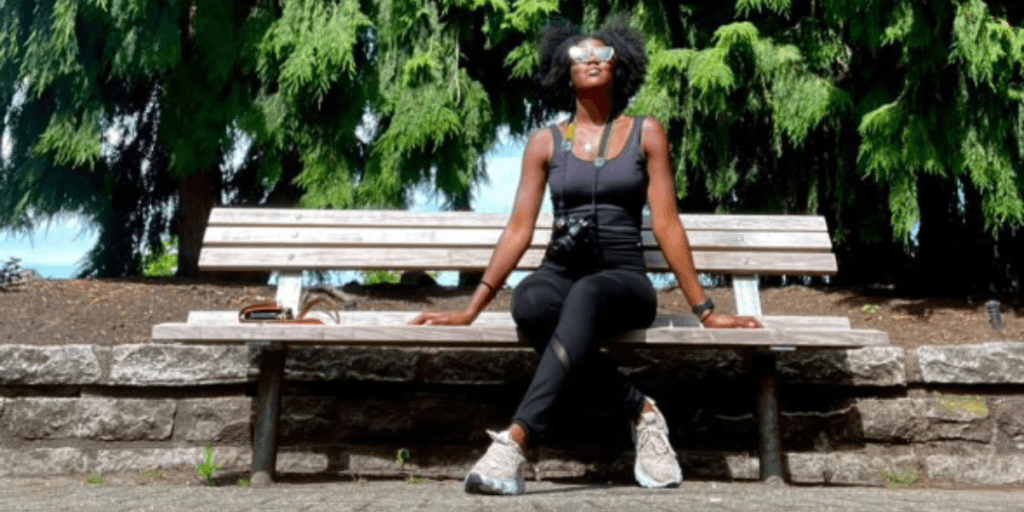Introduction
Hi, I am Ed Hermes – I am an attorney, a dad, husband, School Board member, community advocate, and I became an urbanist by chance. Most of my life I didn’t have a car because I couldn’t afford one so I really came to value walkable streets, safe bike lanes, and good public transit. When I became a dad, I started advocating for better design and planning so that my family and I could walk and bike to work and to school safely. Because of this passion, my good friend Joaquin introduced me to a guy named Sean Sweat many years ago – that is the first time I heard this “urbanist” moniker and it started to fit.
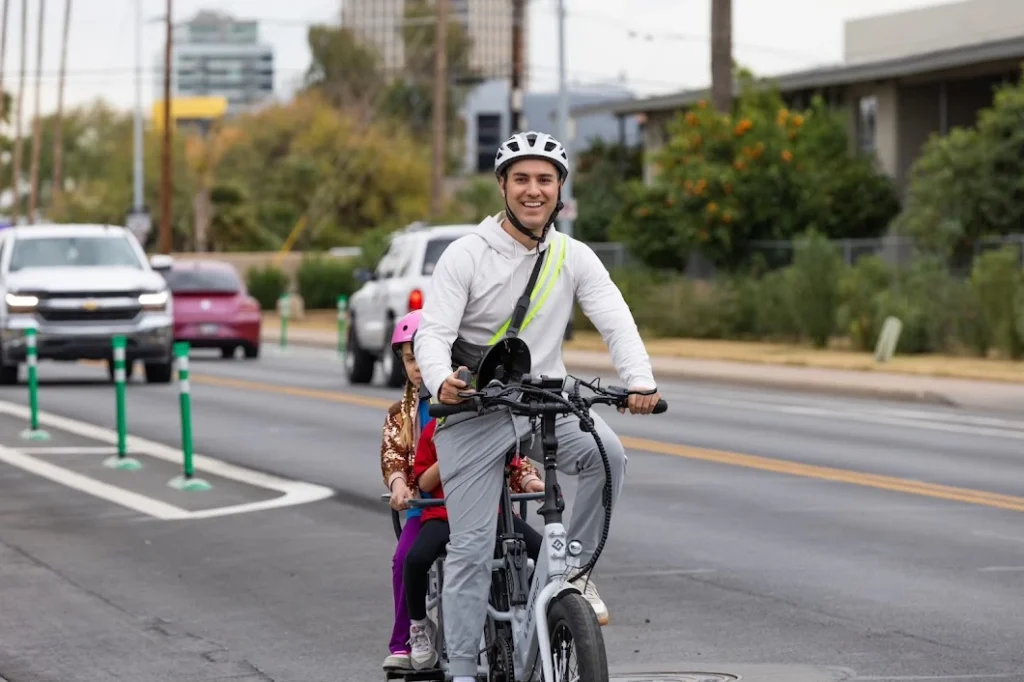
Basic Info
Where are you from?
I was born in a small town in rural Illinois and moved to the Phoenix area when I was 15. After graduating from ASU, I moved to the Navajo Nation to teach high school government. I moved to Tempe to attend ASU Law and lived for a bit in San Juan, Puerto Rico before moving back to Phoenix in 2013 to start my law practice.
What first inspired you to get involved in community work and urbanism? Was there a specific event or moment that made you realize this was an important part of your career and personal life?
I grew up in a small town as a kid, which taught me how important it is to build community to work together for the common good. I moved to a very quintessential Arizona suburb when I was in high school and the lack of walkability, community spaces, and community was isolating. In college at ASU, I realized how much easier it is to meet people, make friends, and build community when I had to walk and bike to get around. Also, when I did own a car when I was younger, I was always having issues with it – getting hit several times by impaired drivers, and having to sink a lot of money into car maintenance because the cars I could afford were old. I eventually realized that car ownership was a ball-and-chain weighing me down and I felt so much more free and mobile using public transit and riding my bike. When the Light Rail opened in December 2008, I was first in line to get on the train. Back then the train ran every 10 minutes and was very consistent, and when I started law school in 2010, I took it every day. When I moved back to Phoenix with my wife in 2013 from living in San Juan for a semester, we made the choice to be car free because we wanted that freedom not to have to worry about a car and we wanted to build community and meet our neighbors in Central Phoenix.
Law and Urbanism
How do you feel your background in law has helped you understand the systems in our cities, and how have you used that knowledge to encourage positive change?
On my first day of law school, my torts professor asked us all the hypothetical question, “If there was a machine that made your work and life more efficient, but in exchange for it you had to sacrifice 50,000 people to it every year, would you make that trade?” Most of us said, “no” to which he responded, that we already make that tradeoff in our society – cars. About 50,000 people are killed by cars every year. This lesson and many more shaped my way of thinking and helped me understand that our laws enshrine our society’s values in many ways. Setting speed limits, development laws, and road design regulations are all areas where our elected and appointed leaders implement our society’s values. Law school also helped teach me that these laws and policies can and should be changed over time to reflect the evolving values of our society. As a young lawyer, I did a lot of volunteering with Community Legal Services and I noticed that 70% of the cases that low income families were having involved cars – whether that was being taken advantage of by car dealerships or auto lenders, being prayed on by title loan companies, having a dispute with a mechanic that overcharged them, or being fired from a job because a car broke down. Families with lower incomes often have to pay a much larger portion of their income to own a car due to higher repair costs, insurance costs, and gas costs (especially as there is less affordable housing in the City now). I realized that we can greatly improve the lives of all families, especially those of modest means if we can provide a reliable, convenient, and inexpensive public transit system.
What legal challenges do cities like Phoenix face when trying to shift toward more sustainable and inclusive city?
Frankly, I think that Cities like Phoenix focus too much on the legal challenges and use perceived legal issues as an impediment for change, when we need to get creative to overcomes those challenges or break down those barriers to benefit the community.
What challenges do you see with the current zoning laws in your city?
Mandatory Parking minimums, State laws that restrict inclusionary zoning, zoning codes that assume car use or car dependence.
Raising Urbanism
Do you ever feel judged by other parents for encouraging your kids to use public transit and ride their bikes? How do you respond to these perceptions, and what do you think it says about broader societal views on urban transportation?
Good question. Yes. There have been times when some parents say, “you can’t have your kids outside riding bikes, it is too dangerous” or “isn’t it dangerous to ride the bus with your kids?” I was even at a City Planning Committee meeting one time talking about Safe Routes to School and a committee member asked me, “you’d never let your kids cross the street would you?”
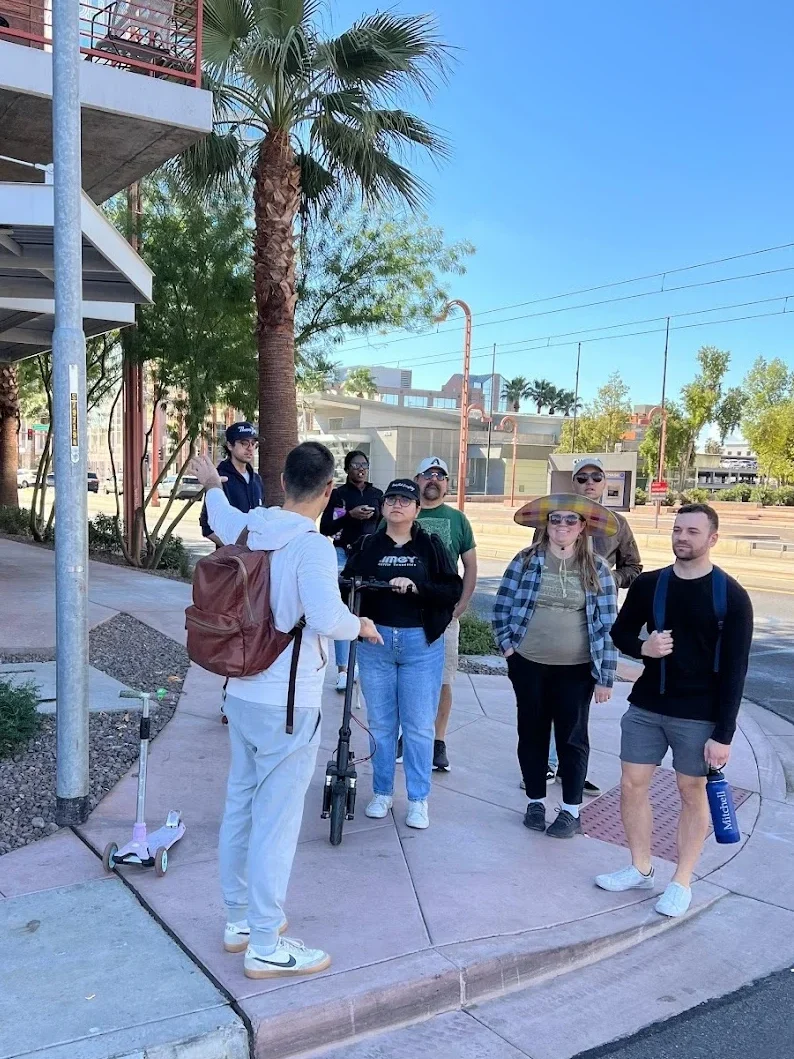
Have your kids’ experiences with public transit and biking shaped your views on how cities should be designed for children? Can you share an example where you noticed this?
My kids love the light rail. We recently worked on a community mural in our neighborhood, and the kids wanted to include the light rail in it. However, from experience, it can be difficult to get around with a stroller due to current policies that require you to collapse the stroller before boarding. This can create challenges where I have to take my kids out one by one while also trying to board and collapse the stroller.
Children are often overlooked in the planning process, even though they will inherit the cities we’re building. What do you think we can do better to encourage cities to involve kids and teens in shaping the urban environments they’re often excluded from?
We need to ask them about what they want their community to look like and to listen and act. I talk to my kids a lot about what our neighborhood and community looks like and we go on a lot of walks and observe what our neighborhood is like. My kids ask insightful questions and make insightful observations like, “why are there no sidewalks here, we need sidewalks here dad.” Also, we need to make space for young people on each of our City Committees and Commissions – adding one or two seats on commissions for young people age 16 – 21. When I was 20, I was appointed to the Arizona Board of Regents and saw how
What advice would you give to other parents who are raising their kids more independently by using public transit and biking?
Don’t feel judged or pressured to conform with a perceived “norm.” Kids love the independence and sense of adventure that they get from riding bikes, walking, and taking transit. My kids love understanding their surroundings. I would say that the fear of safety is reasonable, but that being in a car does not mean you are automatically safe – most injuries from crashes occur when the occupants are inside the car. I would also say to document those areas where you do not feel safe and use that energy to advocate for safer designs and protections. Also, think about the long run – in the long run, the lessons and independence learned by our kids through walking, biking, and taking transit are lessons that will benefit them for years to come in their lives.
Lightning Round!
Best coffee spot in town?
Window Coffee at the Royale – 635 W. Glenrosa. Tell Mauricio that Ed sent you.
Were you Sparky the Sun Devil, the Arizona State University’s mascot?
Yep! from about 2002 to 2004. It was a blast!
Favorite Sport teams?
Phoenix Rising – right on the Light Rail line! I am also a Suns fan and a Green Bay Packers fan (I was born in the Midwest). O, and of course an ASU sports fan.
Best bicycle Parking you’ve seen?
Short Leash Hotdogs on 7th Ave, or Ocotillo on 3rd Street (it is covered and within the courtyard area)
Best part about taking the light rail?
Making new friends and catching up with old friends. Because my neighborhood is near Central, I have met and gotten to know many of my neighbors who also regularly take the Light Rail. I have recruited many of my Board Members for my Neighborhood Association right from the Light Rail. I also love interacting with people of all ages and backgrounds.
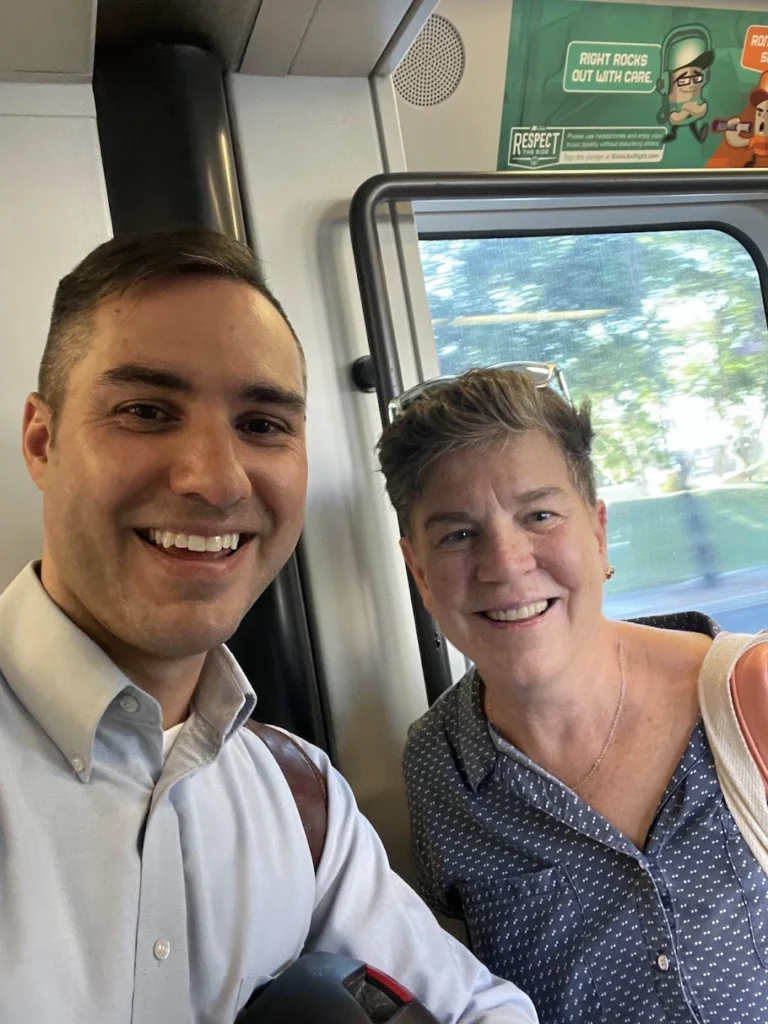
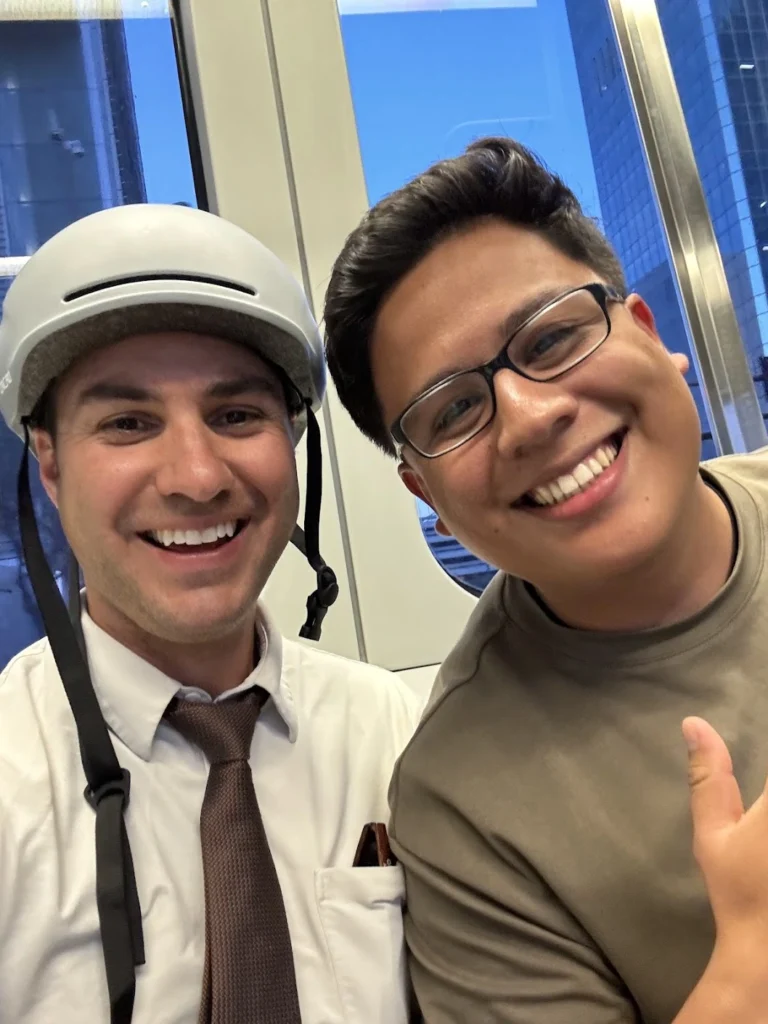
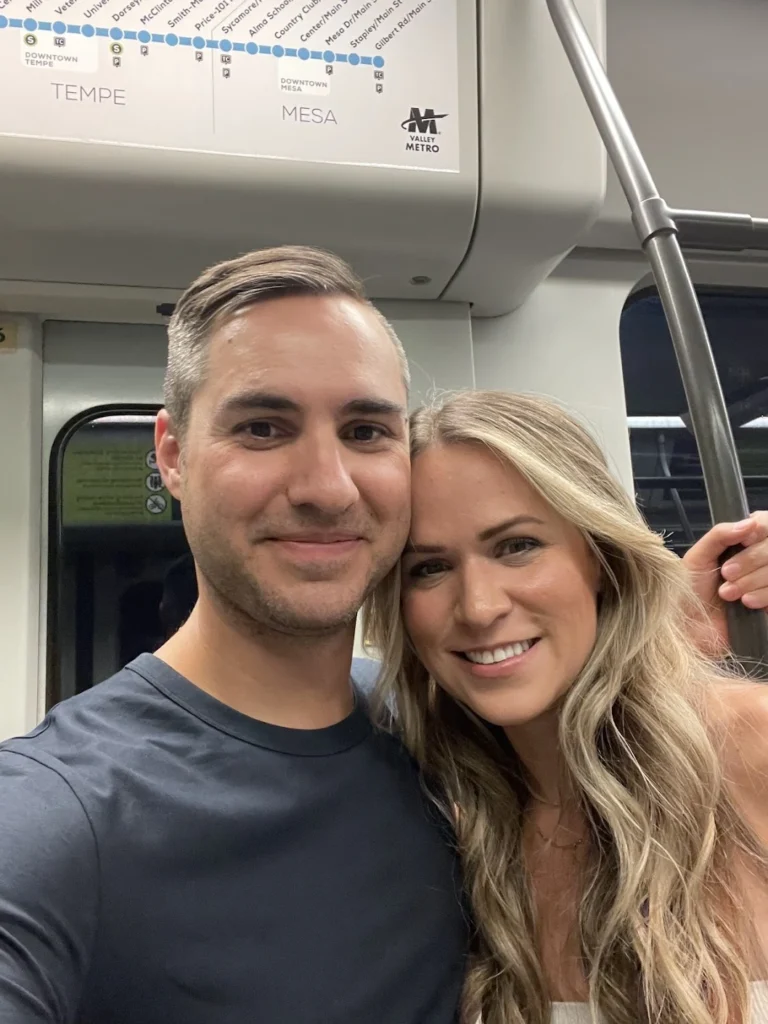
Favorite parking garage in midtown (Satire Question)?
Boo. I would say my least favorite is the 10-story parking garage that the City of Phoenix built at Park Central. It cost the taxpayers at least $33.5 million to build a massive 551,750-square-foot garage that is the tallest parking garage in the State. There is so much more we could have done with $33 million, like building infrastructure to make our city more walkable, like connecting and shading our sidewalks, or improving our public transit system. It is great to see what has happened with the Park Central revitalization, but there is already plenty of parking the 10-story parking garage continues to be 90% empty – I’ve never seen more than just the first floor occupied with cars.
Community in Action
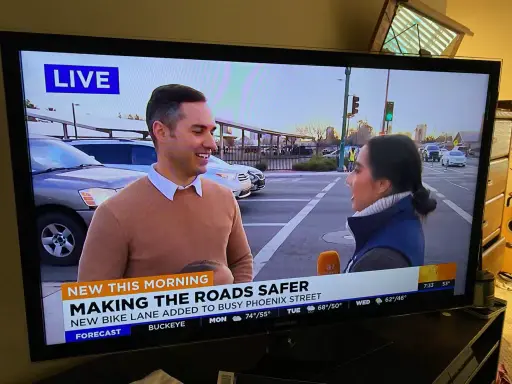
What motivated you to get involved with a local School District and local education advocacy?
I’m a former school teacher and a product of education so I have always wanted to improve public education because strong public schools = strong communities and can give kids the opportunity to succeed. My kids attend their local public school in the Osborn School District, and attend one of the dual language immersion programs. We love the program and our public schools, but I have seen our public schools under attack (and my school district specifically) by some who want to defund public education and eliminate dual language programs. That is why I ran for the school board – to improve public education and protect our popular programs, like our dual language programs.
Can you share a project or initiative in Phoenix that you’re particularly proud of?
I am particularly proud of my work on improving 3rd Avenue. It used to be a patch work of dangerous and unfriendly streets, and it now has several miles of protected bike lanes – some of the best in the City. We still have a lot more work to do, but it is still great to see the progress we have made so far. I’m also really proud of the work we did on Osborn Road to improve the safety around our school and bring in a bike path for our kids near the schools. I spent countless hours talking with neighbors and knocking on doors about these projects and they have made a positive impact in our community.
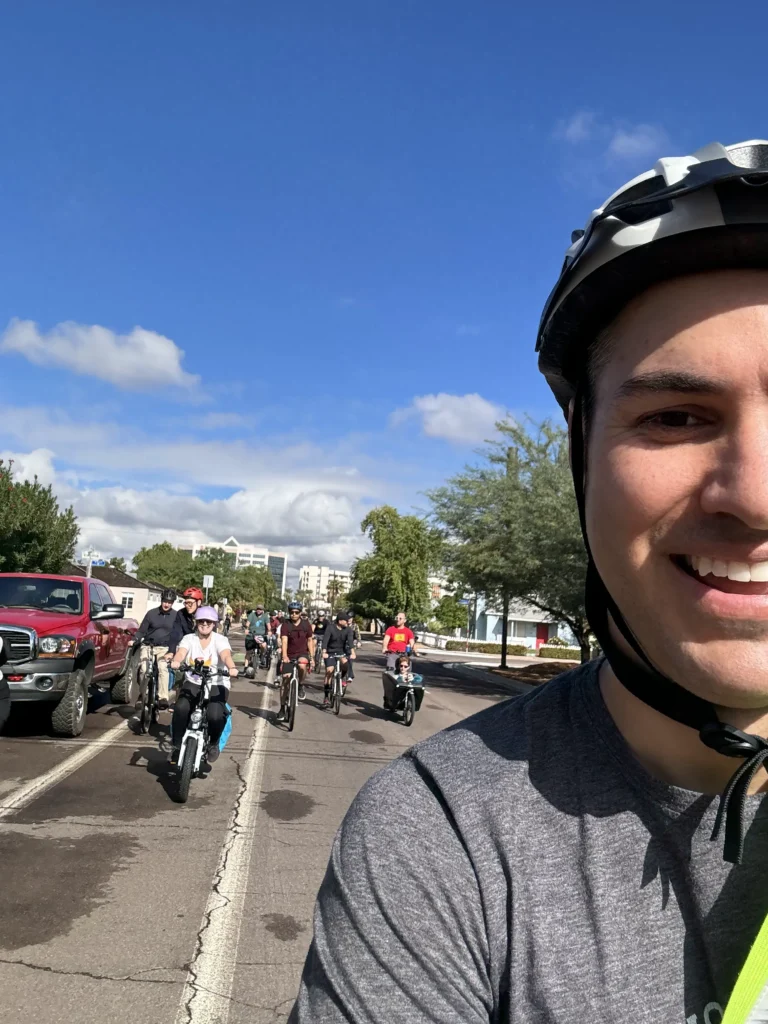
What challenges have you faced in engaging the community, and how did you overcome them?
Finding the time is a challenge. In addition to raising two wonderful girls, I have a full time job, and many community leadership roles. I wish I could be at all of the community meetings that I am interested in (which is many) or spend more time going door-to-door to engage with the community, but there are only so many hours in the day. My wife is a huge help to make sure I am not taking on more than I should be, but it is always a challenge to make sure I am spending my time most effectively to engage the community.
What was the process like for you when starting a neighborhood association? What were some of the biggest challenges, and what advice would you give to others looking to create one in their own communities?
It was great and very empowering! My neighborhood is one of the older neighborhoods in Phoenix. Many years ago it had a neighborhood association, but the association had gone defunct over time. In about 2016, I met some neighbors at the local public school when my daughter started pre school. It was a challenge to learn how to get through some of the red tape of the City of Phoenix and sometimes it is difficult when neighbors disagree on important neighborhood issues, but for the most part there have been a lot of neighbors and City staff that have been really helpful. If you are looking to start a neighborhood association, my advice is to meet someone who is in a neighborhood association already and talk to them about what they have done to build up their association, and to also talk to the City staff at the Neighborhood Services Division, which is a great resource. Also, make sure you have a good core group of neighbors who are willing to share the work. Even a core group of just 4 or 5 people can get so much done!
What advice would you give to someone looking to get involved in their local community?
Just show up and keep showing up. I would start as local as you can – like your local neighborhood association or local public meetings put on by the City. Just show up and listen and share your thoughts when you are ready. And if you see someone who is involved, ask them for advice. Tell them what you are interested in and ask them for help to get connected. There are a lot of people who are “connectors” like you Jamie who can point you in the right direction.
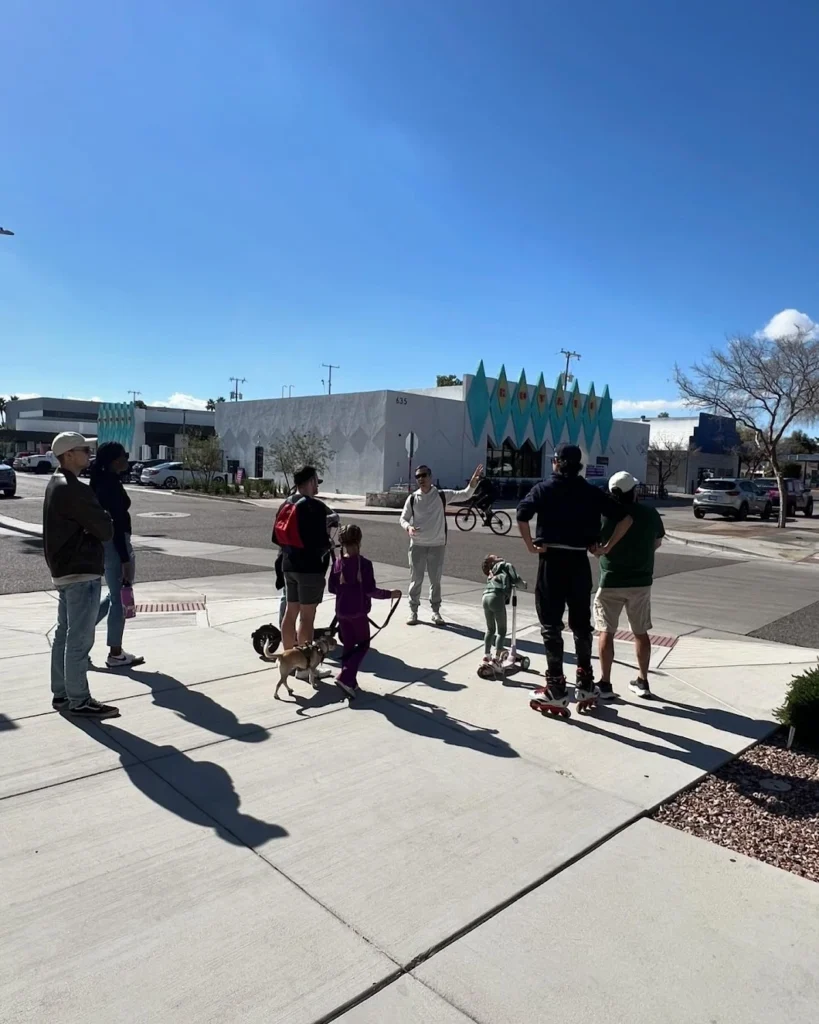
Thinking outside the cage
What’s one common urban planning practice you think needs to be reimagined or completely discarded
Mandatory parking minimums. I live near 7th Avenue, which used to be a bustling and vibrant business district. Then the City did two things to destroy it: (1) implementing the terrible reverse lanes, and (2) implementing mandatory minimum parking requirements to operate businesses. My neighbors who own properties in the 7th Avenue Melrose area have been told by the City that they cannot renovate a historic building and put it to use because the property does not have sufficient on site parking to meet the City’s current requirements. The City is telling people to buy the adjacent property and bulldoze it to put in more parking. This needs to be completely reimagined so we can rebuild our walkable business districts and make them more people-centric.
How can we shift the mindset from car-centric to people-centric in urban planning
I think the best way is to get urban planners and those who influence urban planners (like the Planning Commissions and City Councils) out of their cars to experience our cities in all of the ways that our residents do – on foot, on a bike, on public transit, and in a car. When we can get planners out of their cars, they can realize that they need to design for everyone. Often planners and the officials they report to design around the car because that is the only way they experience their surroundings, which causes poor planning. On the Vision Zero committee, when we are talking about a specific street and looking at why it is dangerous, I try to get out there myself and experience the street on foot, on a bike, and also in a car so I can fully understand the experience all of our residents go through. 40% of people don’t have a car – whether it is because they are young, old, can’t afford one, or some other reason. We are leaving a lot of people behind by being just focused on designing around the car.
In January 2022, you attempted to use a Wendy’s drive-thru on a bicycle because the lobby was closed, but you were denied service. Has this experience influenced your views on car dependency and how it can contribute to discriminatory practices that city planners, intentionally or not, have built into our cities?
Yes! On that day in January 2022, my wife and kids were hungry really wanted chicken nuggets from the Wendy’s near my house. I didn’t have a car and it was less than a mile from my house so I biked over there. It was the middle of the day, but the inside of the restaurant was closed so I had to get in the drive through line. When it was my turn to order, the Wendy’s employees would not take my order. They wouldn’t even acknowledge me. It was like they were telling me – if you don’t have a car or can’t afford a car, you don’t exist. I waited in line for minutes and the people in line behind me started to yell at me to “get out of the way.” I went up to the window to get an answer as to why nobody would take my order and the employees said that they will not serve people unless they were in a car because people who were not in cars could be hit and hurt by cars. It was a bizare reasoning, but it definitely influenced my views on how planning can contribute to inequities. You shouldn’t need to have the money to buy a car just to be served.
Earlier this year, you moderated An Evening with CityNerd, hosted by Urban Phoenix Project and Strong Towns Phoenix. With such an amazing turnout for a June event, how inspired were you to see the urbanism community in Phoenix come together? Do you feel that the community is positioning itself as a place where urbanism can truly thrive in the city?
It was amazing to see everyone coming together from all parts of the Valley. It brings me hope, and I would love to see this become an annual event where we can continue to do this. Lots of ideas were shared, and it felt like a convention of Phoenix urbanists. It was great to see everyone united by similar values. Shout out to Strong Towns Phoenix and Urban Phoenix Project for organizing the event! It was packed, and it was held on a weekday.

A big topic during the event was the reverse lanes on the 7s. As someone who lives near these lanes, how do you feel about them, and how would you reimagine these streets for the future?
The rush hour reverse lanes are terrible. They make it difficult to walk and even to drive on those streets. They also make it more dangerous to drivers and non-drivers and do not contribute anything positive to the community that these roads run through. I talk with businesses owners along the 7s all of the time and these business owners agree that the reverse lanes hurt their business and make it harder for people to access their business. I would return these streets to what they were like before 1979 when the reverse lanes were put in, add in medians in core small business areas, like in the Melrose area of Phoenix, and I would widen the sidewalks to make it safe for families to walk in these areas and add in more trees and shading. In certain business-heavy areas, I would also add back in on-street parking to support businesses and provide a safety buffer for pedestrians to create a walkable district. A lot of people don’t realize that there used to be on-street parking in these areas and when this was taken away, the area became much less walkable, more dangerous, and hurt the businesses that used to thrive along the 7s.
Learn more about End Reverse Lanes.
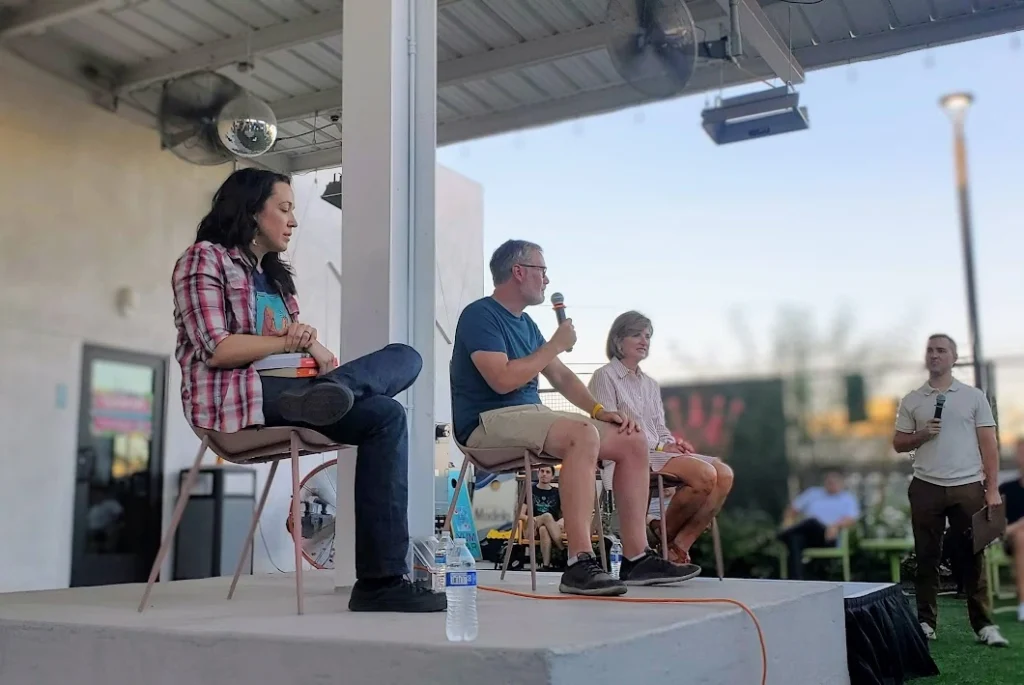
Pedal Away
Is there anything you would like to discuss that we haven’t had the opportunity to cover?
Nope. Your questions are great!
What current projects, initiatives, or organizations would you like to share? How can our listeners get involved or support your work?
I would plug the Phoenix Vision Zero Street Safety Committee and the work we are doing there. Our next meeting is October 23. You can learn more at https://www.phoenix.gov/streets/roadsafety Also, I’d like to plug the Arizona State Capitol Light Rail Extension Street Redesign initiative – we are working to make sure that the City of Phoenix and Valley Metro include designing for pedestrians and cyclists in the redesign. Contact the City of Phoenix, your councilperson, and Valley Metro to let them know that we want a protected bike lane on Washington and Jefferson streets connecting downtown Phoenix with the State Capitol. Finally, I’d like to plug the 3rd Street bikelane project through Downtown Phoenix. We currently have no north-south bikelane through downtown, and almost no protected bikelanes downtown. Contact your Councilperson to let them know that you want the City to complete the bikeway on 3rd Street through downtown. Learn more at: https://www.phoenix.gov/streets/dnsbikeway
